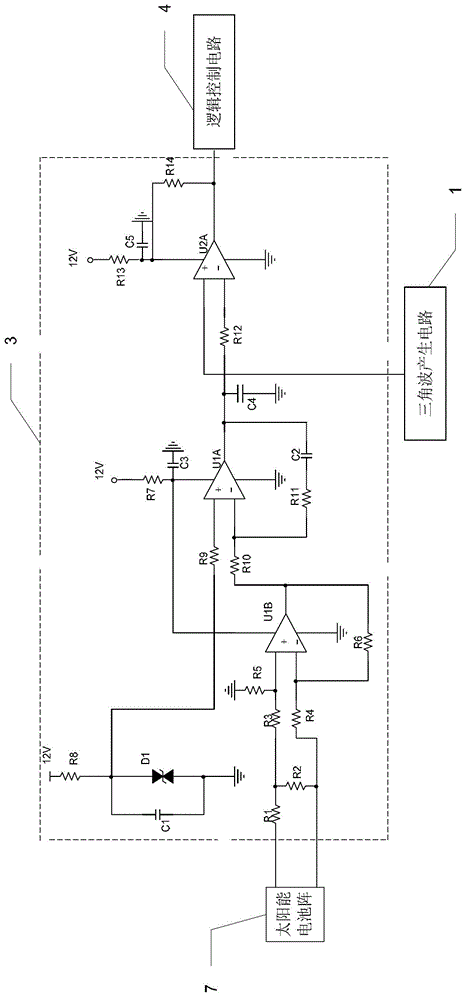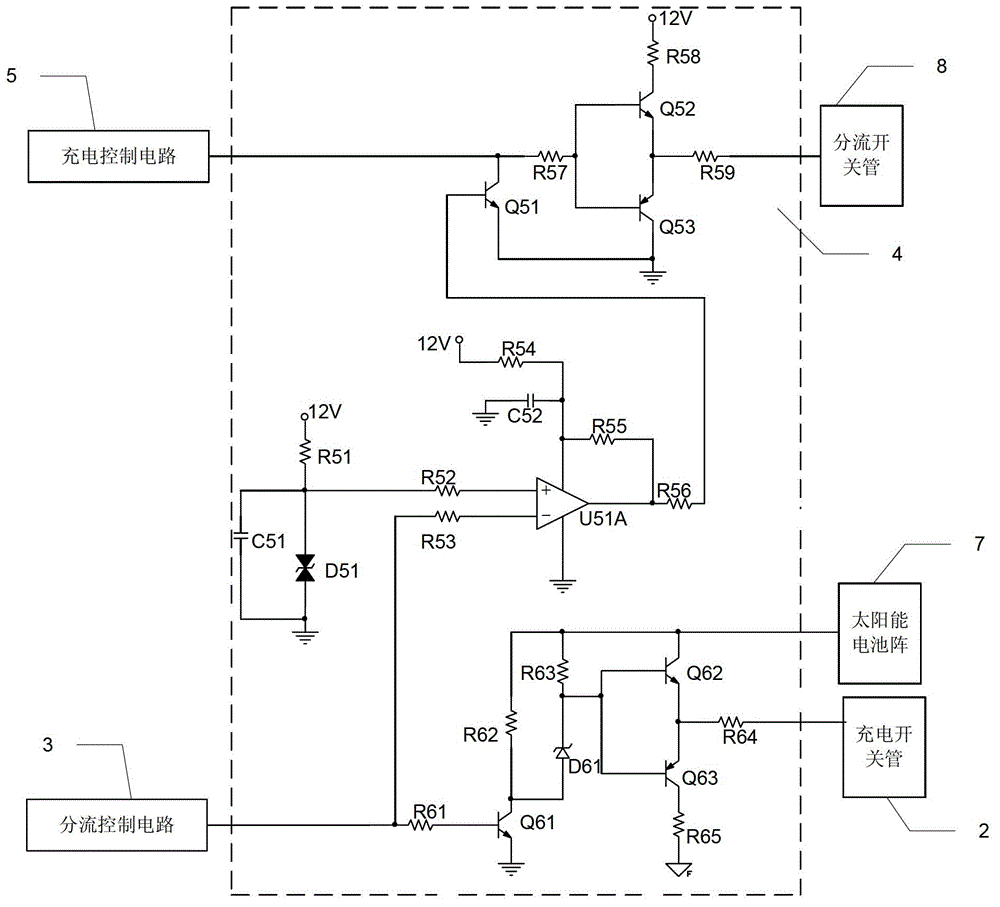S<4>R-type power supply control device
A power control device and charging control technology, applied in circuit devices, battery circuit devices, current collectors, etc., can solve the problems of low performance, heavy weight and large volume, and achieve the effect of high performance, light weight and small volume
- Summary
- Abstract
- Description
- Claims
- Application Information
AI Technical Summary
Problems solved by technology
Method used
Image
Examples
specific Embodiment approach 1
[0044] Specific implementation mode 1. Combination figure 1 Specifically describe this embodiment, a kind of S described in this embodiment 4 The R-type power supply control device includes a first diode, a triangular wave generating circuit 1, a charging switch tube 2, a shunt control circuit 3, a logic control circuit 4, a charging control circuit 5, a lithium ion battery 6, a solar cell array 7, and a shunt switch tube 8 and load 9,
[0045] The solar battery array 7 simultaneously sends the voltage signal to the charging switch tube 2, the logic control circuit 4 and the shunt switch tube 8,
[0046] The solar battery array 7 sends the first voltage signal to the shunt control circuit 3 and the load 9 simultaneously through the first diode,
[0047] The triangular wave generating circuit 1 sends the first triangular wave signal to the shunt control circuit 3 and the second triangular wave signal to the charging control circuit 5 respectively,
[0048] The shunt control ...
specific Embodiment approach 2
[0056] Specific implementation mode two, refer to figure 2 Describe this embodiment, a kind of S described in this embodiment and specific embodiment 1 4 The difference between the R-type power supply control device is that the shunt control circuit 3 includes resistors R1 to R14, capacitors C1 to C5, a first bi-phase voltage regulator diode D1, a first operational amplifier U1B, a second operational amplifier U1A and a third Operational amplifier U2A,
[0057] One end of the resistor R1 is connected to the positive pole of the solar cell array 7, and the other end of the resistor R1 is connected to one end of the resistor R2 and one end of the resistor R3 at the same time,
[0058] The other end of the resistor R2 is simultaneously connected with one end of the resistor R4 and the negative pole of the solar cell array 7,
[0059] The other end of the resistor R4 is simultaneously connected with one end of the resistor R6 and the negative phase input end of the first operat...
specific Embodiment approach 3
[0085] Specific implementation mode three, refer to image 3 Describe this embodiment, a kind of S described in this embodiment and specific embodiment 1 4 The difference between the R-type power supply control device is that the logic control circuit 4 includes resistors R51 to R59, resistors R61 to R65, capacitor C51, capacitor C52, a second dual-phase voltage regulator diode D51, a voltage regulator tube D61, a first NPN The transistor Q51, the second NPN transistor Q52, the first PNP transistor Q53, the third NPN transistor Q61, the fourth NPN transistor Q62, the second PNP transistor Q63 and the fourth operational amplifier U51A,
[0086] The second PWM signal output end of the charging control circuit 5 is simultaneously connected with one end of the resistor R57 and the collector of the first NPN transistor Q51,
[0087] The emitter of the first NPN transistor Q51 is connected to the collector of the first PNP transistor Q53, the collector of the first PNP transistor Q...
PUM
 Login to View More
Login to View More Abstract
Description
Claims
Application Information
 Login to View More
Login to View More - R&D
- Intellectual Property
- Life Sciences
- Materials
- Tech Scout
- Unparalleled Data Quality
- Higher Quality Content
- 60% Fewer Hallucinations
Browse by: Latest US Patents, China's latest patents, Technical Efficacy Thesaurus, Application Domain, Technology Topic, Popular Technical Reports.
© 2025 PatSnap. All rights reserved.Legal|Privacy policy|Modern Slavery Act Transparency Statement|Sitemap|About US| Contact US: help@patsnap.com



